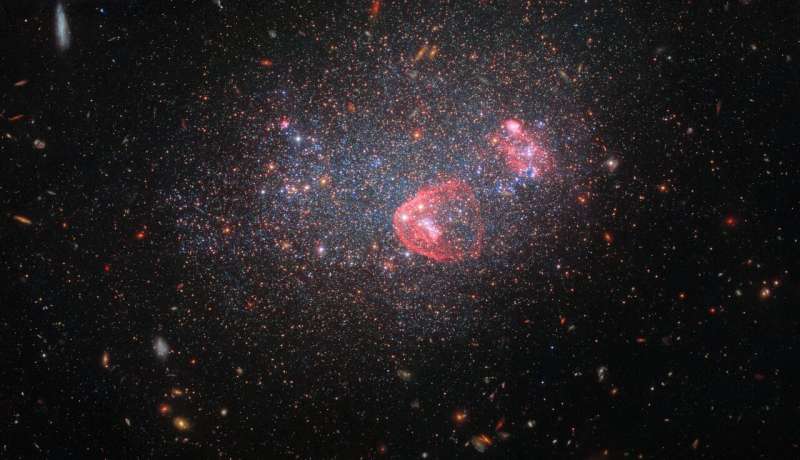This article has been reviewed according to Science X's editorial process and policies. Editors have highlighted the following attributes while ensuring the content's credibility:
fact-checked
trusted source
proofread
Hubble presents a holiday globe of stars

To celebrate the holiday season, the NASA/ESA Hubble Space Telescope has captured the galaxy known as UGC 8091, which resembles a sparkling festive snow globe. With a dazzling array of wavelengths of light captured by filters on Hubble's premier scientific instruments, the millions of stars in this galaxy are being explored in more depth than ever before.
UGC 8091, or GR 8, lies around seven million light-years from Earth in the constellation Virgo. Unlike other galaxies whose stars take a more orderly appearance, UGC 8091 is classed by astronomers as an irregular galaxy. It's not hard to see why—the stars that make up this celestial gathering look more like a brightly shining tangle of string lights than a galaxy.
Some irregular galaxies are thought to have become tangled by tumultuous internal activity, while others are known to have formed by interactions with neighboring galaxies. The result is a class of galaxies with a diverse array of sizes and shapes, including the diffuse scatter of stars that is this galaxy.
In particular, UGC 8091 is a dwarf irregular galaxy that only contains around one billion stars. That's a huge number of lights, but not for a galaxy: our own Milky Way galaxy is thought to encompass over 100 billion stars, and other galaxies can have trillions! Dwarf galaxies often orbit larger galaxies, and their low masses leave them vulnerable to being disturbed and consumed by their bigger neighbors, a process that produces twisted-up dwarf irregulars like UGC 8091.
This type of galaxy is thought to have similar characteristics to the enormously old and distant galaxies seen by astronomers in deep-field images. It's hoped that investigating the composition of dwarf galaxies and their stars, particularly their low metallicity, will help to uncover the evolutionary links between these ancient galaxies and more modern galaxies like our own.
To do this, astronomers have been carefully examining the many-colored stars of UGC 8091. Different features of the galaxy can be picked out by using filters to restrict the light entering Hubble's instruments to very specific wavelength ranges.
Those filtered images can then be recombined to make a full-color image—an astonishing twelve filters combine to produce this image, with light from the mid-ultraviolet right through to the red end of the visible spectrum contributing. The blossoming patches of red represent light emitted by excited hydrogen molecules in hot, energetic stars that have formed in recent starbursts. The other sparkles on show in this image are a mix of older stars.
The data used in this image date from 2006 to 2021programs sought to investigate the role of low-mass galaxies, like UGC 8091, in reionizing the early universe and were taken by two of Hubble's most advanced instruments: the Wide Field Camera 3 and the Advanced Camera for Surveys.
Among other things, the observing programs sought to investigate the role of low-mass galaxies, like UGC 8091, in reionizing the early universe and to examine the results of star formation in low-metallicity galaxies. Despite how small and misshapen they look, dwarf irregular galaxies turn out to hold a great deal of information about our universe—no less than any of the other celestial lights in our sky.
Provided by NASA





















